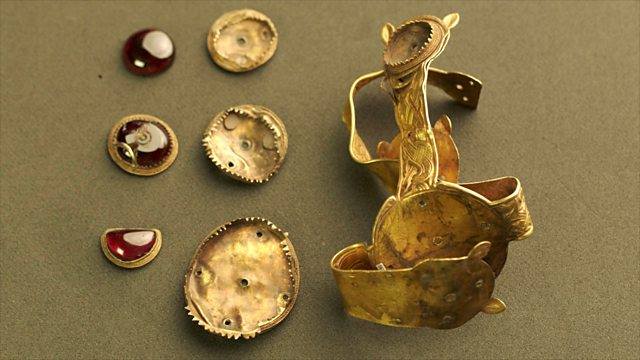Art That Made Us episode 1: This episode immerses us in the turbulent era that followed the Roman occupation of Britain. Once known as the ‘dark’ ages, in reality it’s a time of glittering art and extraordinary cultural fusions. This alternative history of the British Isles, told through art, brings together encounters between contemporary artists and ancient art, and interviews with experts and curators, to trace how Celtic, Anglo-Saxon and Norse peoples fought for supremacy, leaving behind mysterious fragments of art that still haunt our landscapes and imagination.
Sculptor Antony Gormley meets Spong Man, a unique clay figure that once sat on a 5th-century funerary urn, a mysterious glimpse into the mindset of early Anglo-Saxon settlers. Meanwhile, actor Michael Sheen performs the 7th-century Welsh poem of resistance against the Anglo-Saxons, Y Gododdin, and Scottish artists Dalziel & Scullion wonder at the monumental Aberlemno Stones (c.500-800 AD), believed to mark the hard-fought boundary line of the Pictish kingdom.
Like the stones, the gold artefacts of the Staffordshire Hoard fuse pagan and Christian imagery, and at Stoke’s Potteries Museum artist Cornelia Parker investigates why they were found so broken and twisted. Spreading alongside such Christian symbols was a powerful new language, English, used to gloss over the Latin in the elaborate Lindisfarne Gospels explored by the Rev Richard Coles. Maria Dahvana Headley analyses how English was used in the epic poem Beowulf and tells us how she has updated the work with a hip-hop feminist translation.
The Anglo-Saxon Mappa Mundi reveals a new sense of the Isles’ place in the wider world, and is examined by map artist David McCandless and British Library curator Claire Breay. Graphic novelist Woodrow Phoenix explores how the Anglo-Saxon age came to a dramatic end in 1066 by taking a fresh look at the embroidered propaganda of the Norman conquest in the Bayeux Tapestry.
Art That Made Us episode 1
The Roman conquest of Britain refers to the conquest of the island of Britain by occupying Roman forces. It began in earnest in AD 43 under Emperor Claudius, and was largely completed in the southern half of Britain by 87 when the Stanegate was established. Conquest of the far north and Scotland took longer with fluctuating success.
The Roman army was generally recruited in Italia, Hispania, and Gaul. To control the English Channel they used the newly formed fleet.
The Romans under their general Aulus Plautius first forced their way inland in several battles against British tribes, including the Battle of the Medway, the Battle of the Thames, and in later years Caratacus’s last battle and the Roman conquest of Anglesey. Following a widespread uprising in AD 60 in which Boudica sacked Camulodunum, Verulamium and Londinium, the Romans suppressed the rebellion in the Defeat of Boudica. They went on eventually to push as far north as central Caledonia in the Battle of Mons Graupius. Even after Hadrian’s Wall was established as the border, tribes in Scotland and northern England repeatedly rebelled against Roman rule and forts continued to be maintained across northern Britain to protect against these attacks.
Spong Man – Art That Made Us episode 1
In the 5th century the principal means of disposing of the dead was by cremation, the practice of burning the corpse. The ashes were placed in handmade earthenware urns. The pots may have been closed with stoppers made from organic material, but a few urns with pottery lids have been excavated, reflecting a continental tradition likely to have been imported to England alongside other aspects of the cremation rite. A few lids may have been highly ornate, as shown by this remarkable example shaped as a seated figure.
This urn lid was found during excavations at Spong Hill, North Elmham, Norfolk, within the largest known Anglo-Saxon cremation cemetery. It had become separated from its urn, but the size of the rim shows that it must have belonged to a large, narrow-necked vessel. When complete, the decorated urn and its lid would probably have stood about 35 cm tall.
This figure is unique among surviving examples of Anglo-Saxon pottery and the closest parallels are from north Germany. Although popularly called ‘Spong Man’, the figure has no features to define its sex. It is one of very few three-dimensional representations of humanoid figures from the entire Anglo-Saxon period, although an emerging group of small metal figurines provides some points of comparison. It may be that the Spong Hill urn lid is an example of many other representational depictions of the human figure in art of this period and long since lost.
Aberlemno Sculptured Stones
The Aberlemno Sculptured Stones are a series of five Class I and II Early Medieval standing stones found in and around the village of Aberlemno, Angus, Scotland.
Aberlemno 1, 3 and 5 are located in recesses in the dry stone wall at the side of the road in Aberlemno. Aberlemno 2 is found in the Kirkyard, 300 yards south of the roadside stones. In recent years, bids have been made to move the stones to an indoor location to protect them from weathering, but this has met with local resistance and the stones are currently covered in the winter. The stones are covered with wooden boxes from the last working day of September until the first working day of April.




